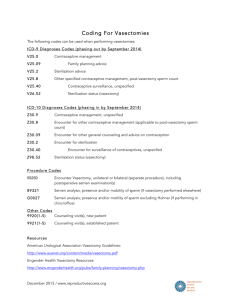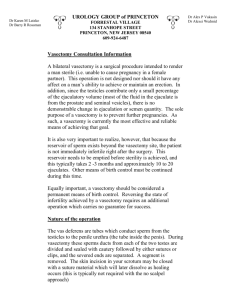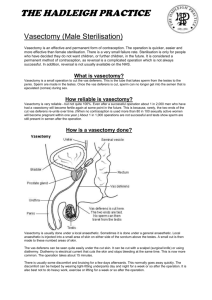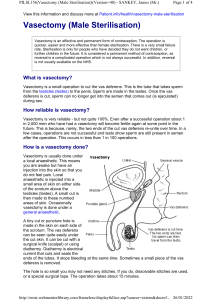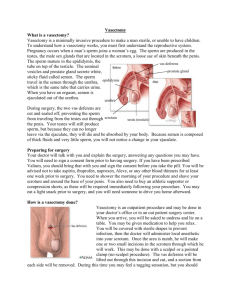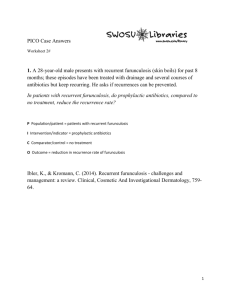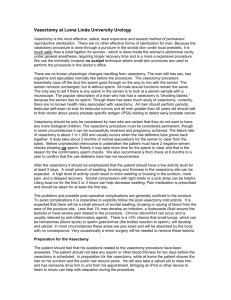Vasectomy information leaflet
advertisement
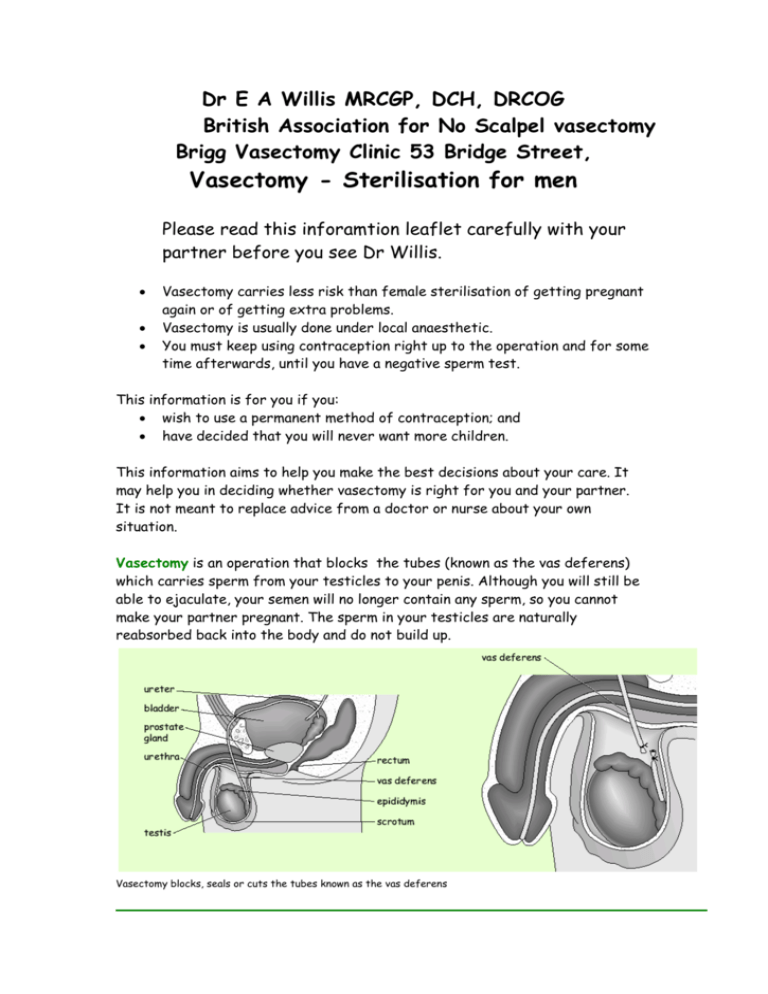
Dr E A Willis MRCGP, DCH, DRCOG British Association for No Scalpel vasectomy Brigg Vasectomy Clinic 53 Bridge Street, Vasectomy - Sterilisation for men Please read this inforamtion leaflet carefully with your partner before you see Dr Willis. Vasectomy carries less risk than female sterilisation of getting pregnant again or of getting extra problems. Vasectomy is usually done under local anaesthetic. You must keep using contraception right up to the operation and for some time afterwards, until you have a negative sperm test. This information is for you if you: wish to use a permanent method of contraception; and have decided that you will never want more children. This information aims to help you make the best decisions about your care. It may help you in deciding whether vasectomy is right for you and your partner. It is not meant to replace advice from a doctor or nurse about your own situation. Vasectomy is an operation that blocks the tubes (known as the vas deferens) which carries sperm from your testicles to your penis. Although you will still be able to ejaculate, your semen will no longer contain any sperm, so you cannot make your partner pregnant. The sperm in your testicles are naturally reabsorbed back into the body and do not build up. Vasectomy blocks, seals or cuts the tubes known as the vas deferens What do I need to consider? If you have a partner you should discuss and agree together which option suits you best as a couple. Your doctor or nurse can talk to you about your choices and help you to come to a decision. Research has shown that you are more likely to have regrets later on if you are under 30 or if you do not have children already. About 1 in 100 men on average go to the trouble and expense of reversal of their vasectomies. Are there alternatives? Couples need to consider both vasectomy and long term female contraception. There are other long-term methods that women can use to avoid getting pregnant. They include: Copper IUDs (which used to be known as the coil) - the IUD (intrauterine device) is put into your womb and can safely stay there for up to eight years. If you are over 40 when it is fitted, it can be left in until you reach the menopause. A progestogen IUS (intrauterine system) - this is a hormone-releasing IUD that lasts for five years. The Mirena system is as effective as vasectomy and more effective than tubal occlusion. Progestogen implants – this uses a small flexible tube inserted under the skin of the arm to release the hormone progestogen. The implant lasts for three years. The main advantage of these methods is that they can be reversed. Like female sterilisation and vasectomy, they all have risks and benefits. Your doctor or nurse can tell you more about them. How well does sterilisation work? Sterilisation fails if the tubes that have been cut or blocked as part of the operation join up later on. You can get pregnant immediately or at any time (even several years) after a failed operation. There is much less chance of a pregnancy after a vasectomy than after a female sterilisation. A pregnancy results for only 1 in every 2000 men who have been given the all-clear (that is, after tests have confirmed there are no sperm in their semen) after a vasectomy. It seems that the longer it is since you had your vasectomy, the lower the risk that your partner will get pregnant. The main risk after a vasectomy is that your partner gets pregnant because you stop using contraception too soon after the operation; that is, before you have had a negative sperm test. Can it be reversed? All sterilisation operations are meant to be permanent. The chances of an operation to reverse it being successful vary a great deal. There is no guarantee of success. Reversals are not available on the NHS and they are very expensive. What happens first? You will be invited to make an appointment with Dr Willis at The Bridge Street Surgery. You will be asked about your medical history and whether you have had any operations before. Please let us know about operations in the groin area including hernias, and if you have a pacemaker!! you will not be suitable for the usual method! Medication allergies are also important. The doctor should tell you more about what the operation involves before you make a final decision. You should have a chance to talk about the operation in detail, to raise any questions or worries you may have and to think about what it will mean for you. You will usually be prescribed some diazepam medication to reduce anxiety for the operation. Before the operation you should not shave but do use scissors if you have a very hairy scrotum! Vasectomy: What does it involve? Vasectomy is done under local anaesthetic; local anaesthetics work well but rarely do cause serious reactions. General anaesthetic is an unnecessary risk. The surgeon will usually make one small cut in the skin of your scrotum to reach the tubes (the vas deferens) which carry sperm. They will then block the tubes and close the ends using diathermy to heat and seal them off. The surgeon will use the ‘no-scalpel’ way of reaching the tubes. This technique was invented in China about 20 years ago. This avoids cutting the skin; the surgeon uses a special instrument to make a tiny hole and then stretches a small opening in the scrotum. This cuts the risk of bleeding, infection and pain. No stitches are needed, just a simple wound dressing. Usually there is no bleeding. You can be driven home and then should rest for the whole day. Most people take a few (1-4) days off work. Strenuous sports should probably be avoided for 2 weeks or so. You must use effective contraception before the operation and until followup tests show that the vasectomy has been successful. To find out whether your vasectomy has been successful you will be asked to give one semen sample, at around 16 weeks after the operation. Wait 10days for the result. If there are no moving ie living sperm in your semen, the test result is negative. You will be told that you can stop using contraception. If you still have some sperm in your semen, you will be given another test. You must wait until you get a negative test before you stop using contraception. Vasectomy: What are the risks? There is no evidence that having a vasectomy affects your sex drive, or the experience of having sex. As an operation it carries less risk than sterilisation does for women. Having a vasectomy does not increase the risk of getting testicular or prostate cancer or heart disease. Any surgical wound can become infected or develop a haematoma from bleeding inside the wound. These problems are unusual (about 1 in 50) with no scalpel vasectomy. Some men get pain in one or both of the testicles after a vasectomy. It can happen immediately or some time (even a few months) after the operation. It may be occasional or it may be quite frequent. Some men find the pain continues over time; this is known as chronic pain. For most men, however, any pain is quite mild and they do not need further help for it. It is uncertain whether the operation is responsible for this problem. We have operated on many hundred patients. None have come back complaining of pain that has lasted more than a few weeks at the most. Some men notice some blood in the semen after the operation. This is harmless. Some men will be aware of small pea sized lumps forming on the vas deferens tubes. These are again harmless. They are separate from the testicle itself and cannot become cancerous. Other organisations www.fpa.org.uk www.vasectomy-information.com Sources and acknowledgements This information is based on the Royal College of Obstetricians and Gynaecologists (RCOG) guideline Male and Female Sterilisation (published by the RCOG and revised in January 2004



